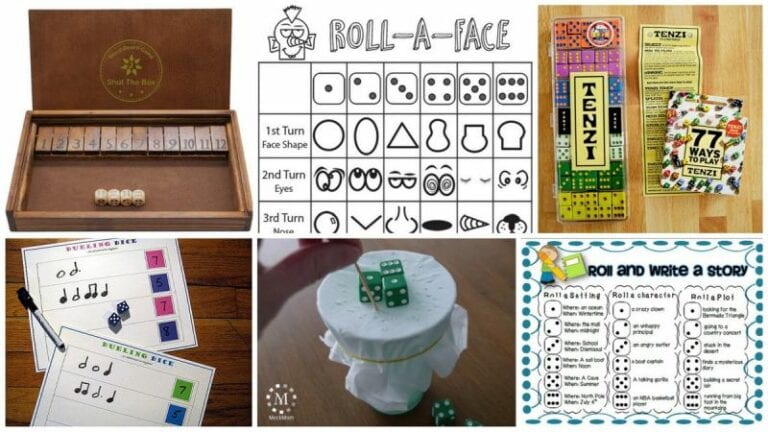Need a way to get students more excited about building math skills? A deck of playing cards might just be the answer. These math card games work for little ones and older kids alike, and they’re all free to learn and play. Draw a few to add to your winning math class hand today!
1. Match to make 11
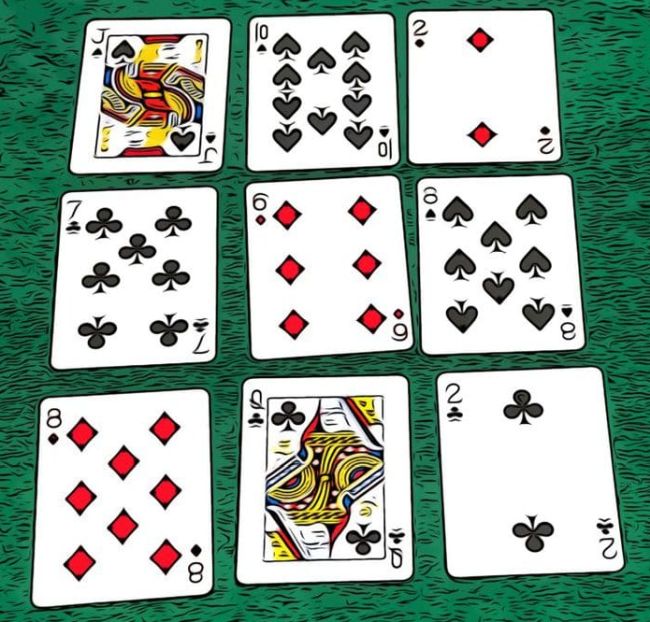
Game Rules/Elevens Card Game Rules via gamerules.com
Lay out three rows of three cards each, face up. Then check to see if you can find any two cards that add up to 11. If so, remove those cards and set them aside. Replace them with new cards from the deck. Continue until you run out of cards or can’t make any more matches.
Learn more: Game Rules
2. Race to 100
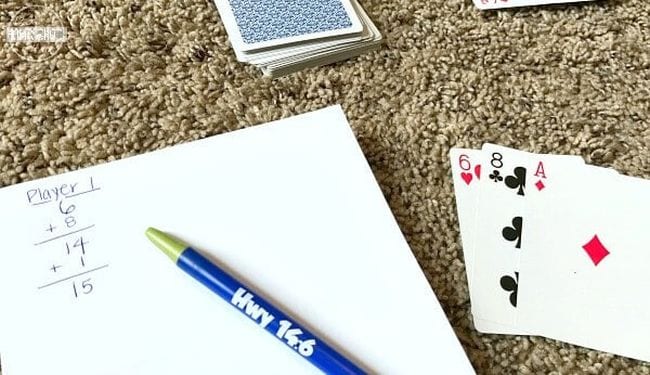
123 Homeschool 4 Me/Adding to 100 card game via 123homeschool4me.com
Flip a card and add its value to your running total. First person to reach 100 without going over wins! (Remove face cards for younger players; use these values for older kids: Jack = 11, Queen = 12, King = 13, Ace = 0.)
Learn more: 123 Homeschool 4 Me
3. Play a game of 21
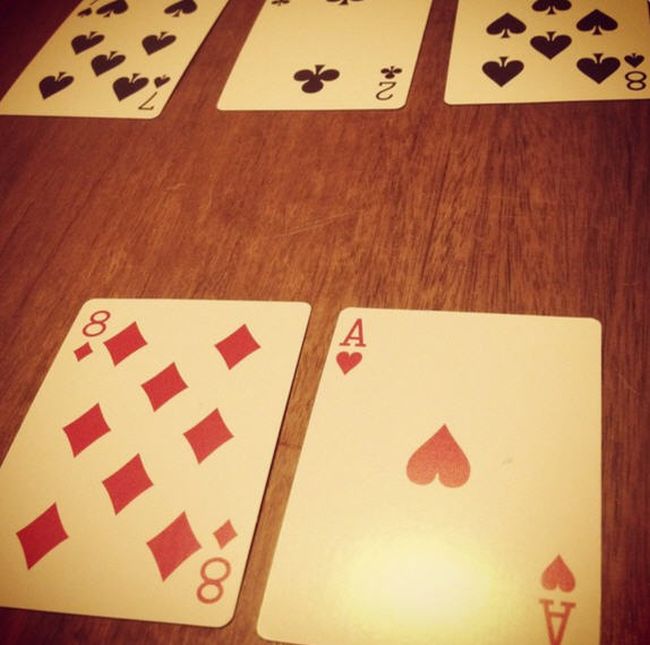
Planning With Kids/21 Card Game via planningwithkids.com
In Vegas, they call this one Blackjack, but it makes a great learning game for kids too (no need to place bets!). Not only do they practice their addition skills, but they’ll also get a little practice at thinking logically and calculating the odds.
Learn more: Planning With Kids
4. Try pyramid solitaire alone or in teams
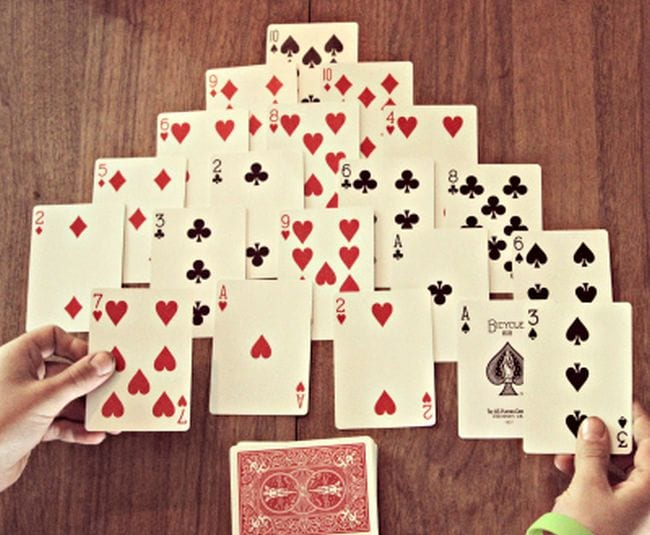
Multiplication.com/Sum of 10 Pyramid Solitaire Card Game via multiplication.com
Some versions of solitaire are really just sneaky math card games, and pyramid is one of them. Try to find cards that add up to 10 as you clear your pyramid row by row. Learn how to play at the link below.
Learn more: Multiplication.com
5. Flip and add 1 or subtract 1
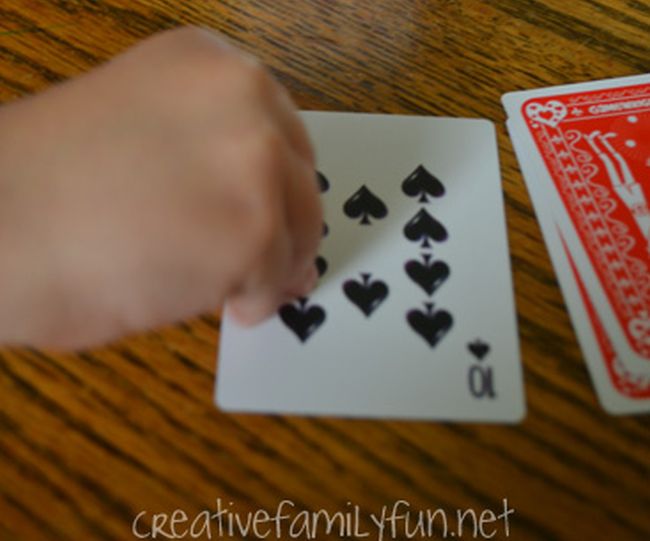
Creative Family Fun/Plus 1 Minus 1: An Easy Math Card Game via creativefamilyfun.net
There are a few versions of this basic addition and subtraction game. We like this one: Remove the face cards from the deck. Flip a card. If it’s red, add 1 and say the amount out loud. If it’s black, subtract 1. If you get it right, you get to keep the card.
Learn more: Plus 1 Minus 1/Creative Family Fun
6. Go fish for pairs that make 10
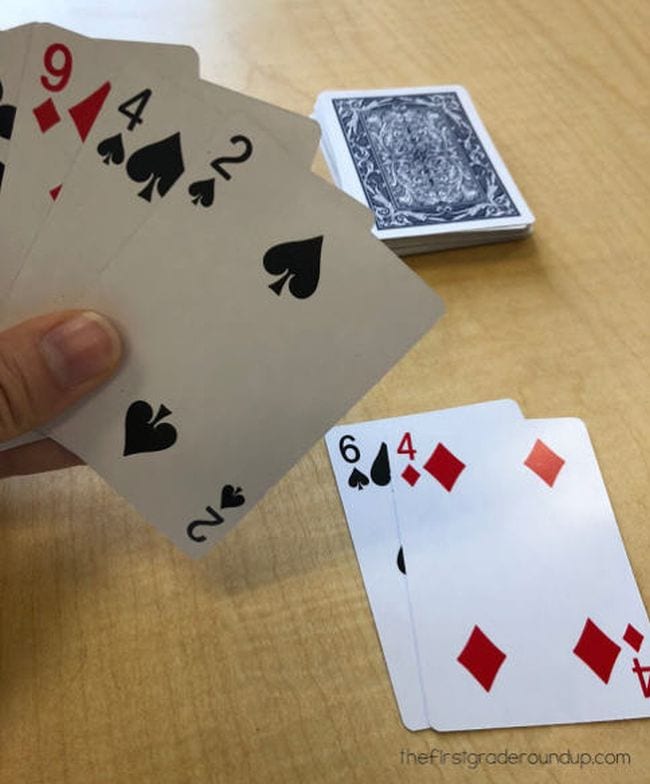
The First Grade Roundup/Tens Go Fish via thefirstgraderoundup.com
Your students probably already know how to play Go Fish, but in this version, they’re fishing for pairs that add up to 10. Have them ask: “I have a 2. Do you have an 8 to make 10?” Change aces to 1 for this game and leave face cards out entirely.
Learn more: Go Fish/The First Grade Roundup
7. Calculate the gain or loss
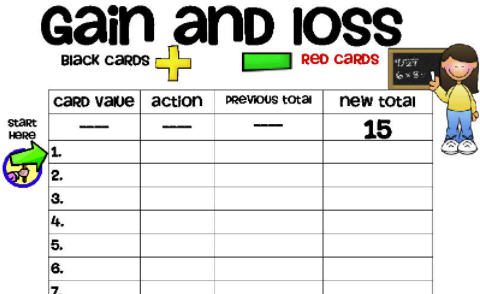
My Teaching Spirit/An Addition and Subtraction Game via teacherspayteachers.com
Each player starts with 15 points. Player one flips a card (remove face cards or assign them point values first). If the card is black, they add it to their total. If it’s red, they subtract it. Highest point total when all the cards are gone wins! Get a free printable worksheet to use with this game at the link.
Learn more: Teacherspayteachers.com
8. Practice counting on with cards
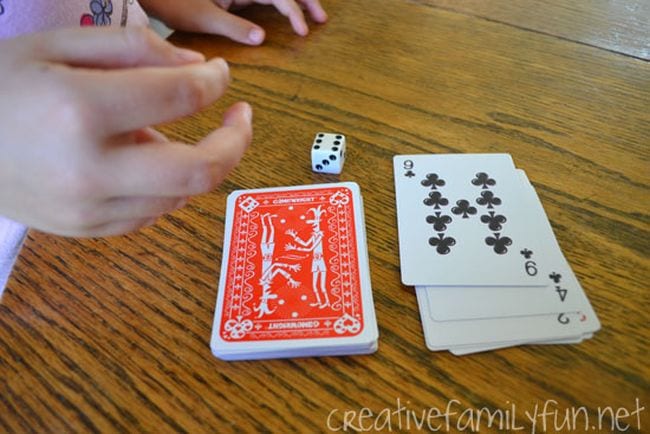
Creative Family Fun/Counting On Card Game via creativefamilyfun.net
Remove the face cards for this one, and grab a die. Players flip a card and roll the die. Starting with the number on the card, they “count on” using the number on the die. For instance, if the player flips a 7 and rolls a 4, they would say, “7 … 8, 9, 10, 11.” If they get it correct, they keep the card.
Learn more: Creative Family Fun
9. Card turnover and multiply (or add)
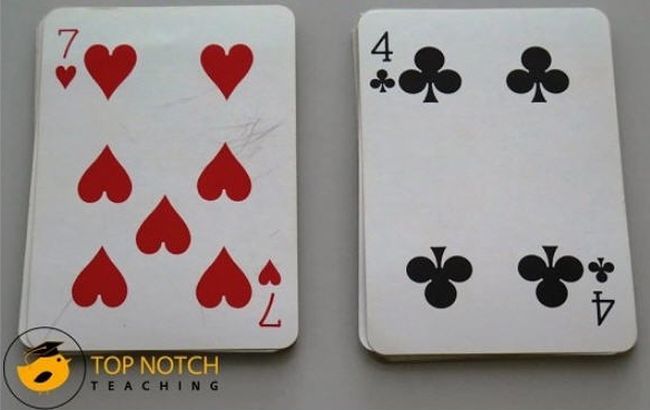
Top Notch Teaching/Card Turnover Math Game via topnotchteaching.com
This one is so simple! Have students pair up. One person flips two cards from the deck. The first student to multiply (or add, depending on what you want to practice) them correctly and call out the answer wins and takes both cards. Play continues until all the cards are gone, and the winner is the one with the most cards.
Learn more: Turnover/Top Notch Teaching
10. Try for a total of 10
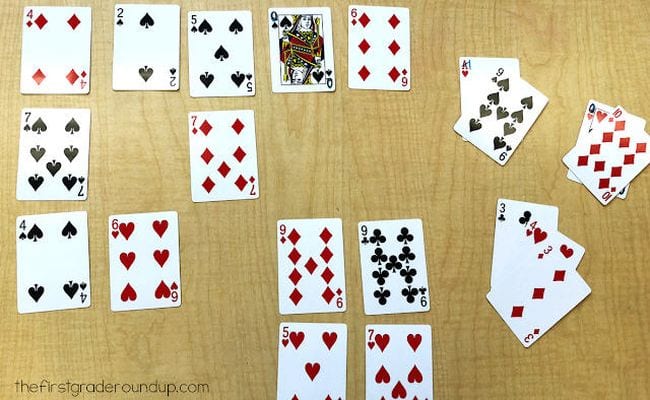
The First Grade Roundup/Total of 10 via thefirstgraderoundup.com
Play this math card game alone or as a team. Lay out 20 cards on the table (leave out face cards or change them to equal 0, while aces equal 1). Kids remove sets of cards that add up to 10, ultimately trying to remove all the cards from the table. It’s harder than you think!
Learn more: Total of 10/The First Grade Roundup
11. Practice number sequencing with Builder’s Paradise
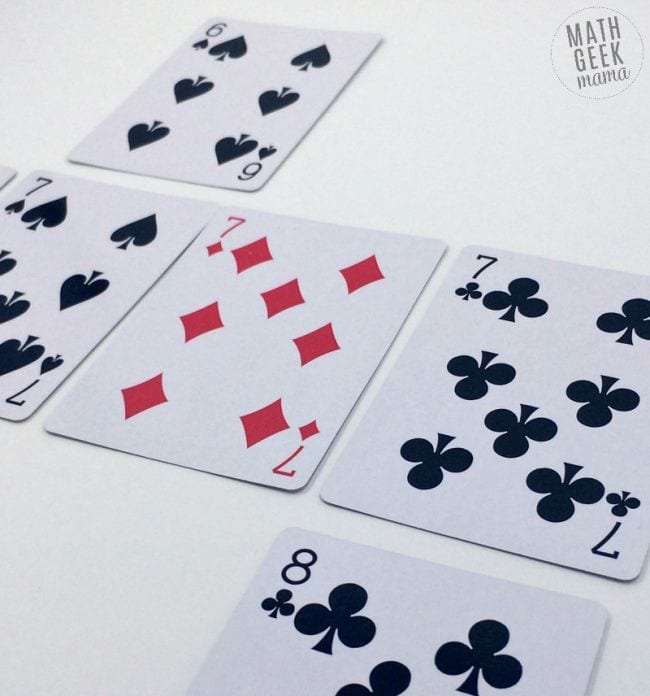
Math Geek Mama/Builder’s Paradise via mathgeekmama.com
Simple math card games can help kids learn how to put numbers in order. To play Builder’s Paradise, discard the face cards and lay out the four sevens in a deck side by side. In each round, players work to add the next higher or lower number in each suit, trying to be the first to get rid of all their cards. Get the full how-to at the link below.
Learn more: Builder’s Paradise/Math Geek Mama
12. Add decimals to “make a buck”
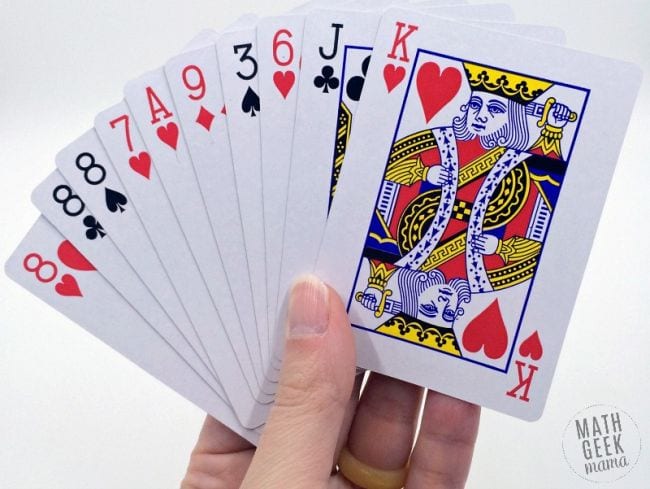
Math Geek Mama/Make a Buck via mathgeekmama.com
Draw, swap, and discard to make a hand that equals $1. Learn what face cards equal and get all the rules at the link.
Learn more: Make a Buck/Math Geek Mama
13. Declare a fraction war
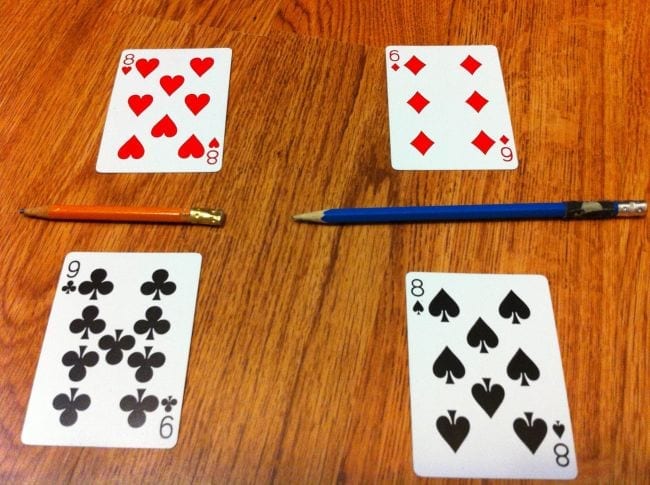
Math File Folder Games/Fraction War via mathfilefoldergames.com
War is one of the original math card games, but this version adds a fraction aspect. Students deal two cards—a numerator and denominator—then determine whose fraction is the largest. The winner keeps all four cards, and play continues until the cards are gone. (Click here for more fun and free fraction games.)
Learn more: Math File Folder Games
14. Learn numbers with card bingo
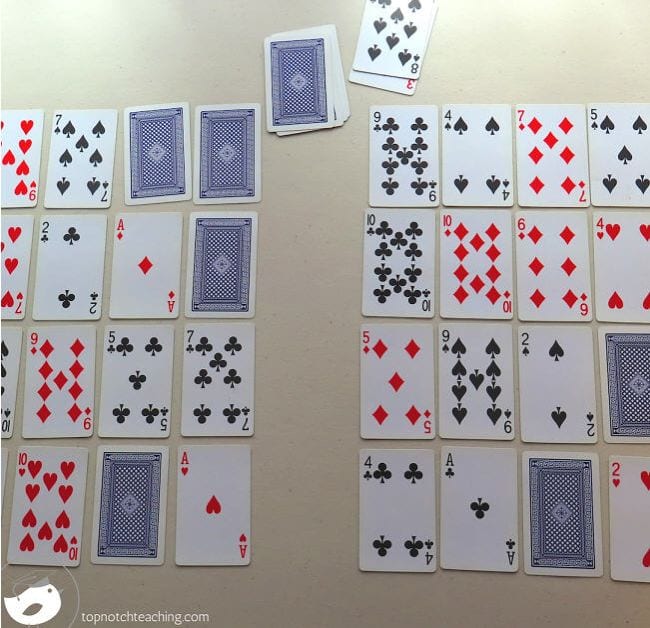
Top Notch Teaching/Card Bingo via topnotchteaching.com
Remove the face cards and have each student lay out a 4 x 4 playing “board” of cards. The remaining cards (or another deck) are placed face down, and a caller flips over a card. Any player who has that number on their board turns the card face down. Play continues until one player has a row flipped over horizontally, vertically, or diagonally and calls “Bingo!”
Learn more: Card Bingo/Top Notch Teaching
15. Play a game of “I Spy”
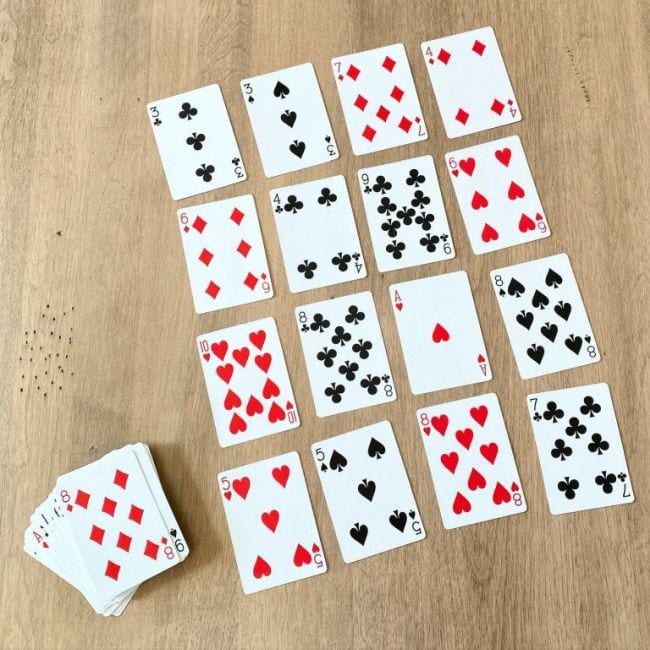
Susan Jones Teaching/I Spy via susanjonesteaching.com
Lay out cards on the table, then take turns giving clues. “I spy two cards that add up to 12.” Differentiate for younger kids with options like, “I spy a card that’s less than 4,” or for older ones: “I spy two cards that are factors of 12.”
Learn more: Susan Jones Teaching
16. Use order of operations to get to 24

Learn With Math Games/24 Math Game via learn-with-math-games.com
Math card games aren’t just for little kids—even adults will find this one a bit tricky. Each player is dealt four cards, then uses the order-of-operations rules to try to make a number as close to 24 as possible. Simple but challenging!
Learn more: Learn With Math Games
17. Take a gamble with triple-digit dare
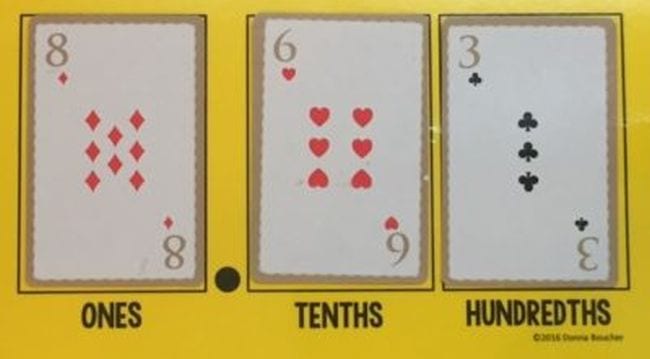
Math Coach’s Corner/Triple Digit Dare via mathcoachscorner.com
Each player gets three cards and privately determines the highest three-digit number they can make (you can use decimals or not, depending on age). Then, each player has a turn to stick with the cards they have, swap with one from the deck, or steal one of the other player’s. All players then lay down their best number to see who wins. See more at the link below.
Learn more: Math Coach’s Corner
18. Deal and round to tens to win
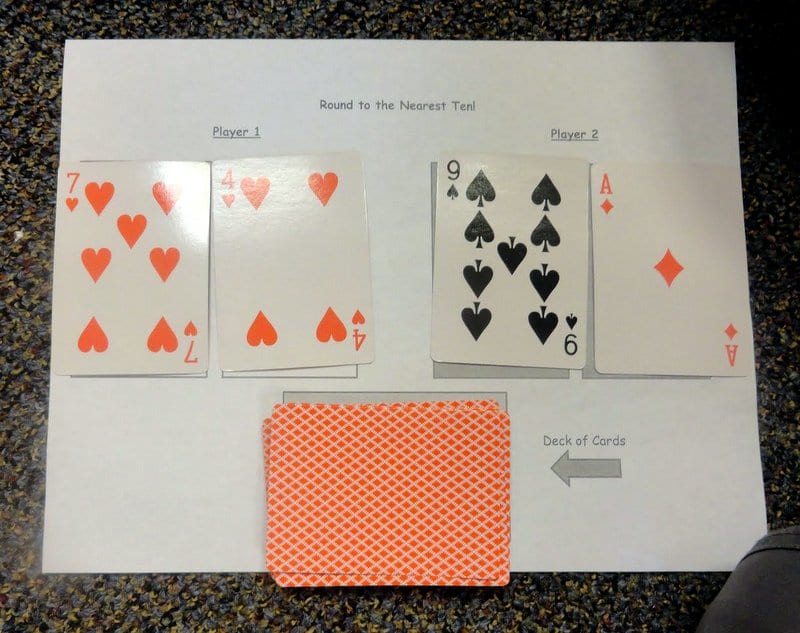
Adventures in Third Grade/Common Core: Rounding via adventuresinthirdgrade-brown.blogspot.com
Each player deals two cards and lays them on the board. Then, round to the nearest 10 to find the winner of that hand.
Learn more: Adventures in Third Grade
19. Find a way to make 10
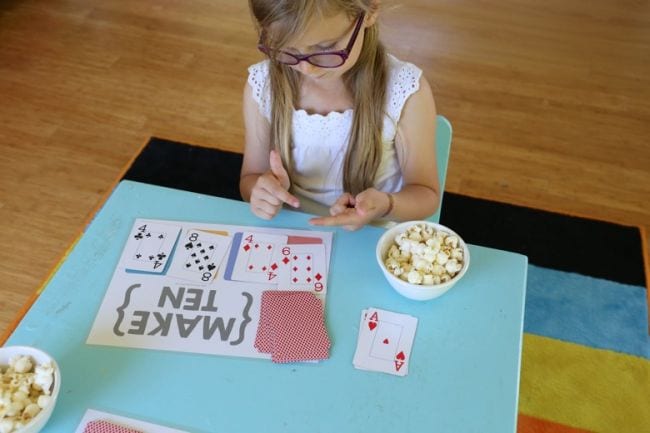
Mama.Papa.Bubba./Make Ten via mamapapabubba.com
One of the terrific things about math card games is that many of them can be customized for various concepts and skill levels. The original goal of this game was to look at the cards you’re dealt to find ones that add up to 10, but it can be changed to 15, 20, or any number you choose. You can also add to the difficulty by allowing addition and subtraction (for example, you could use 8 + 4 = 12 and 12 – 2 = 10). Get the rules and free printable mats at the link below.
Learn more: Mama.Papa.Bubba
20. Use Close Call to practice two-digit addition or subtraction
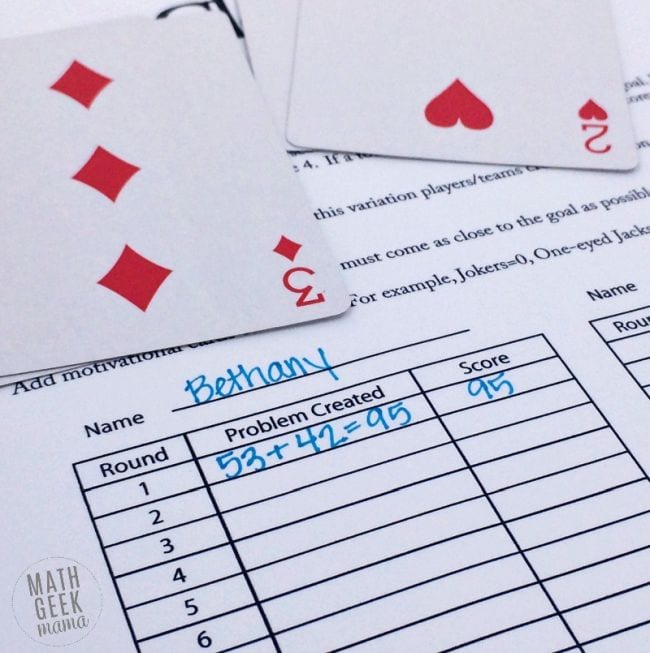
Math Geek Mama/Close Call via mathgeekmama.com
The best math card games are simple at heart. To play Close Call, each player deals themselves four cards, then determines how to arrange them so they make two two-digit numbers that add up as close as possible to 100 without going over. For a subtraction version, work to get as close to zero as possible. Learn how to play at the link.
Learn more: Close Call/Math Geek Mama
21. Let card color indicate negative or positive
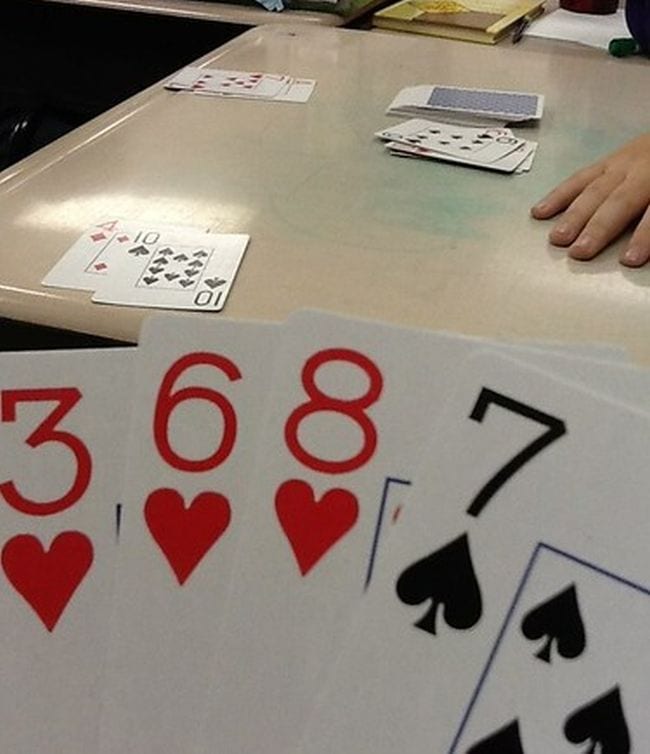
Filling the Frame With Learning/card color game via mesmrswhitesclass.blogspot.com
In this game, red cards are negative integers, while black cards are positive. Students attempt to play pairs of cards that total 6 or –6. You can change the goal number as needed.
Learn more: Filling the Frame With Learning
22. Take a trip around the card spiral to practice math facts
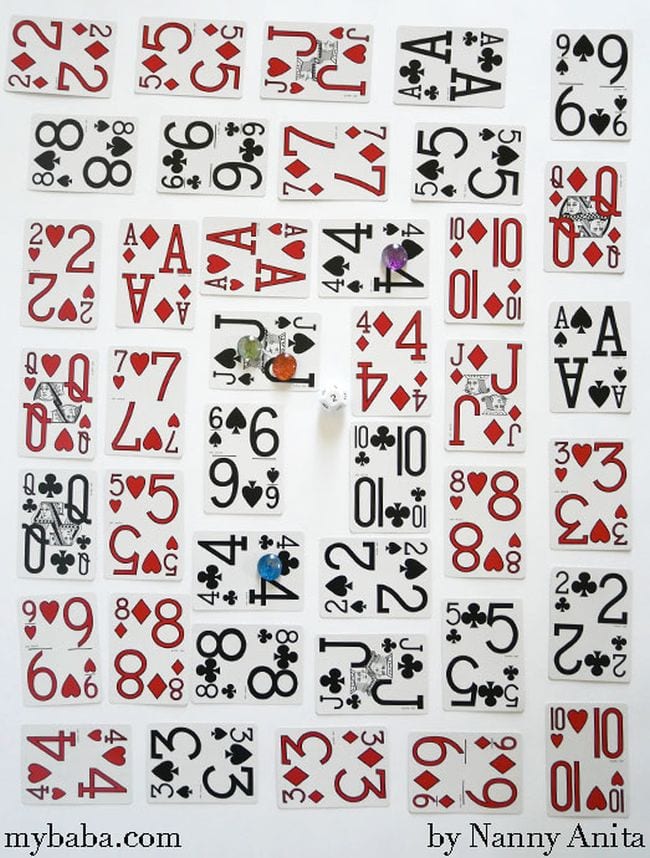
My Baba/Times Table Card Game via mybaba.com
You’ll need a pair of dice for this math card game. Lay out cards randomly in a spiral formation as shown, and set a marker for each player on the center card. Player one rolls the dice then moves their piece that number of spaces shown. They then must multiply (or add or subtract, depending on preferences) the card number by the number on the dice. If they get the answer correct, they stay where they are. If not, they return to their original card. Play continues until one player reaches the end.
Learn more: My Baba
23. Flip to make a prime number
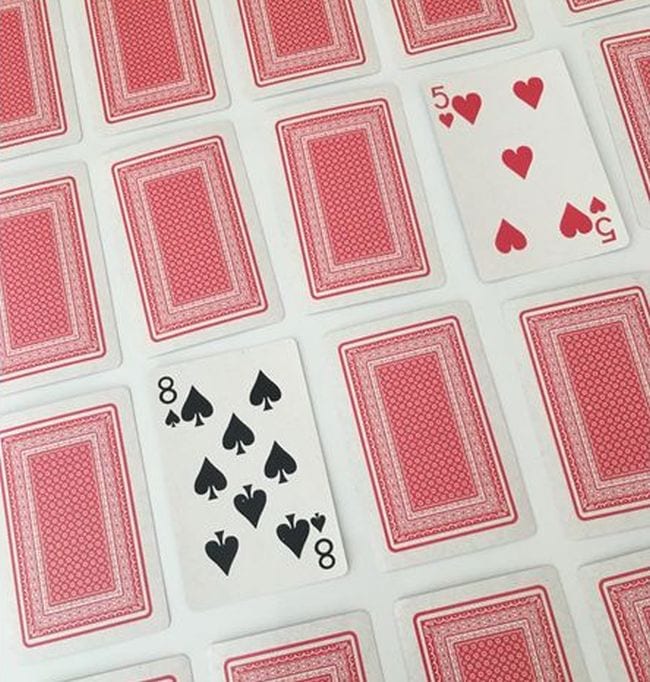
Games 4 Learning/Make a Prime via games4learning.com
Flip two cards. If you can add, subtract, or multiply them to make a prime number (use one or all of these operations), you get to keep them.
Learn more: Flip for Prime/Games4Learning
24. Be the fastest in the race to pi
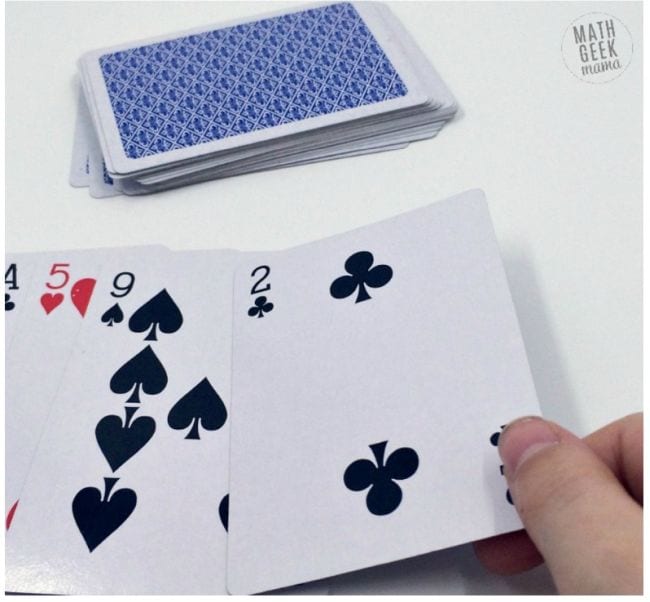
Math Geek Mama/Race to Pi via mathgeekmama.com
In this game, kids work to lay out the digits of pi in order. It’s a simple draw-and-play game that will help familiarize students with this important number. You can write out the digits first or see who knows them from memory. Find out how to play at the link below.
Learn more: Race to Pi/Math Geek Mama
25. Pick three to make number sentences
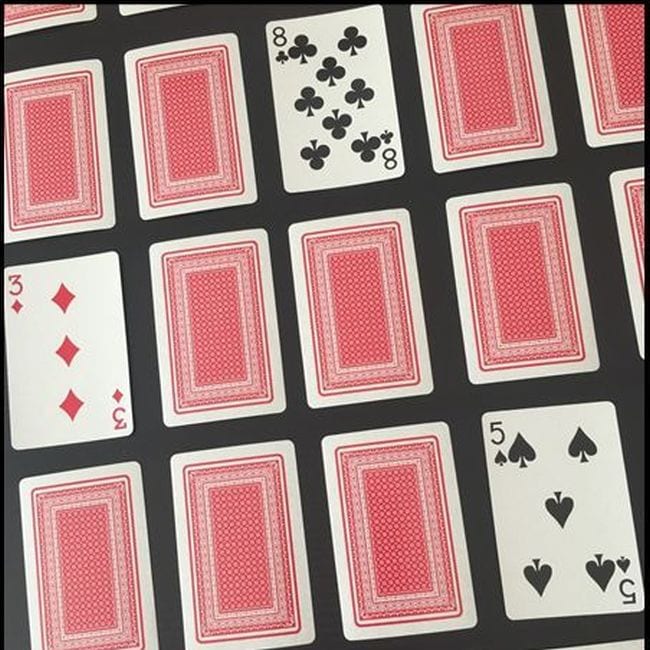
Games 4 Learning/Pick Three via games4learning.com
Flip any three cards. If you can use them to form a valid equation (8 – 3 = 5), you keep the cards!
Learn more: Number Sentences/Games 4 Learning
26. Do some basic fast facts practice
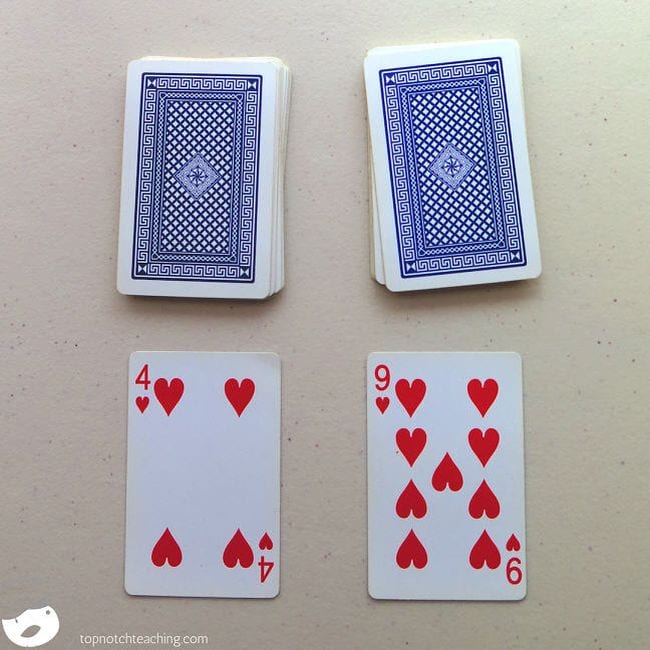
Top Notch Teaching/Fast Facts via topnotchteaching.com
Give your flash cards a rest and practice facts with math card games instead. Simply lay down two cards from the deck (remove the face cards first) and add, subtract, or multiply them. Kids can work on this alone, or you can make it a contest to see who can call out the correct answer first.
Learn more: Fast Facts/Top Notch Teaching
27. Challenge them to beat the teacher
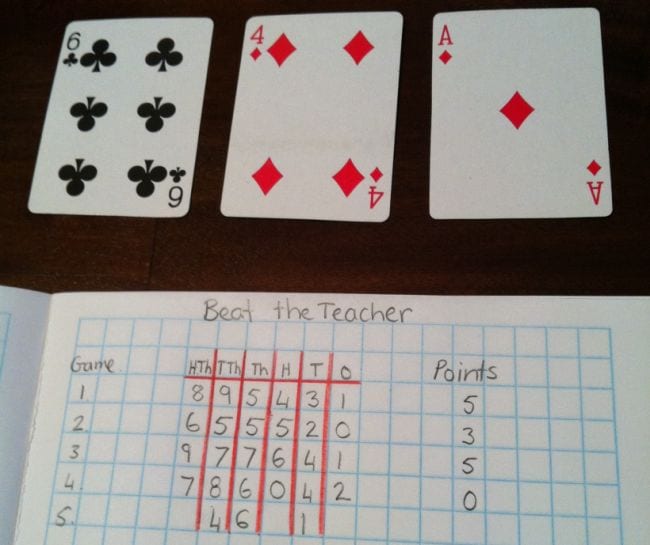
The Teaching Love Fest/Beat the Teacher via teacherspayteachers.com
Practice place value by drawing cards and trying to build the largest number possible. Kids play against the teacher to see who wins! Get the rules at the link below. (Find more fun place value activities here.)
Learn more: The Teaching Love Fest/TpT
28. Read minds to figure out the correct numbers
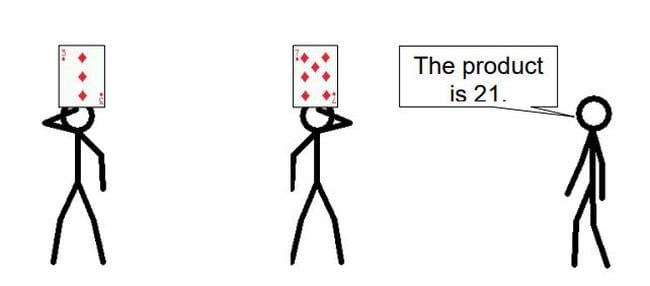
Acing Math/reading minds via pepnonprofit.org
Two students draw a card from the deck without looking and hold it up to their forehead facing out. A third student mentally multiplies the numbers and gives them the product. The students then must figure out what number each is holding. You can do this with addition and subtraction too. You’ll find this game along with dozens of other math card games in the free printable book at the link below.
Learn more: Acing Math (PDF)
If your students like math games, try these dice games that teachers and students will love!
Plus, sign up for our free newsletters and get all the latest teaching ideas, straight to your inbox!
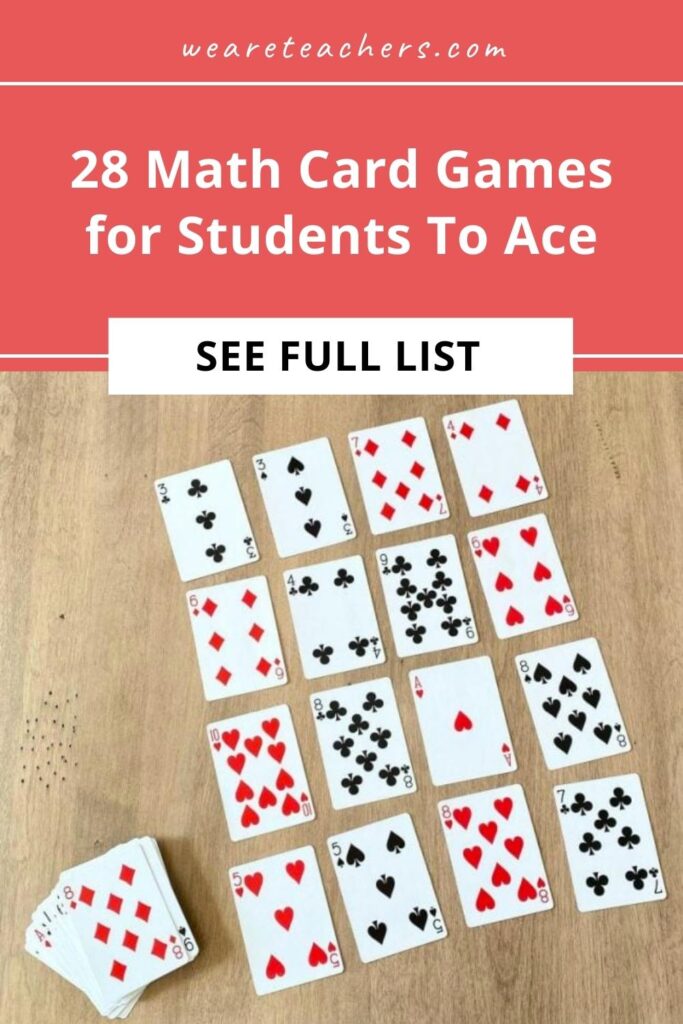
We Are Teachers

